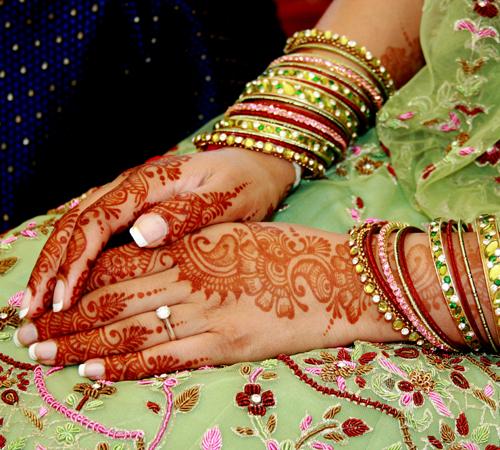
How does the wedding day look?
Picture this. Your fiance arrives at the venue either on horseback, by car. You can hear the noise but you are anxiously busy getting ready. His friends and relatives celebrate by dancing to the accompaniment of a band.
He has the tikka (red dye) applied to his forehead. The samayu takes place and he is greeted by young ladies from your family. As well as performing aarti or pokhvanu your mother or another family member grabs his nose gently to symbolize the tradition of a groom rubbing his nose on the door to ask the bride's parents' permission to marry you. All in good fun.
He walks to the mandap, (the marriage tent), by himself and traditionally his feet are washed. While he is occupied, your sisters might steal his shoes and he may have to barter for them at the end of the day. The fun and games continue.
Then as he watches, you arrive. Instead of walking with your maternal uncle to the mandap, your uncle might carry you, (kanya agamana) - a tradition started in the days of child marriages or your brothers may bring you in a dholi. Or you may simply arrive hand in hand with family.
To symbolize your acceptance of your fiance, you place a garland around his neck, (jayamala), and during the ceremony it may be hard for you to garland your groom, as he may stand on a higher level than you.
In kanyadaan your father and mother give you away, (handing over), I call this offering the hand in marriage, and in haste melaap, (taking of hands); both your hands are joined in marriage.
During the varmala ceremony, your parents and other relatives place a lucky cord around both of your necks signifying the strength of the marriage bond.
The Marriage Fire - Guajarati's and Hindus perform this rite only four times to symbolise the four basic human goals, (dharma, artha, kama and moksha).
In past times, when you and your fiance/husband finished the fourth circuit, you would race to see who sat first in order to see who would be the most dominant and it would be a chance for you to show your cunning and intelligence. Nowadays, it has just become a competition between you and your husband - make sure that you win it!
Your husband signifies your change in status from a single woman to a married one by painting the centre parting of your hair with the red dye, vermilion, (sindhoordaan), and he places a mangalsutra necklace around your neck.
The Seven Steps - The Seven Steps ceremony, (sapta padi), may also differ in how it is conducted from the typical Hindu wedding in that instead of facing north and walking seven steps together as you recite the desired blessings, your husband helps you to touch seven betel nuts with your right toe while you recite sacred words of friendship. This is a decision that is taken from the heart on the day. I will involve you in this decision.
As you are standing at the altar, several of your married female relatives whisper blessings into your ear, (akhand saubhagyavati), and your husband intercedes when it is your mother's turn by grabbing her sari or dress. It's time for your dad to empty his pockets I am afraid.
With the ceremony finished, you and your husband are expected to touch the feet of both sets of parents and the priest to ask for their blessing (ashirwaad) on your marriage.
Vidai - is a traditional and emotional for your parents and for you as you bid farewell and leave the paternal home to begin a new life with your husband.
The above gives you a flavor of the wedding. Of course there may be slight variations to the above.
